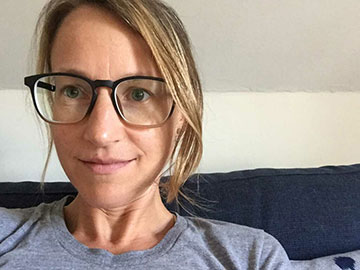Go to a wide field some windy afternoon. Look toward the horizon, where the animals, one by one, will stutter out of view. Lie down in what looks like the center. Grind the aching blue sky, if you can, to a fine powder and scatter it across the dirt as you mouth the options.
Tuck those away in your pocket. Then, fiddle with your zippers and pull up your hood.
Begin with a fact: most treatments for cancer at this stage are merely palliative.
There is too much silk, so I sew my mother a parachute. I think thick seams might hold more air, keep her aloft.
I pull out her IV and strap the parachute to her back, then climb steep red stairs to the attic. I open a window. She sighs. Wind catches her breath and the canopy fills.
Dense clouds weight the sky. The canopy crumples from its apex. Tumors drop from her torso, as if she is being slowly wrung out. Updrafts snap against silk, until the parachute is an orange husk on snow.
On bike rides home from daycare, we spot Mary in the front yards of triple-deckers and houses with faux stone fronts and incongruous diamond-paned windows. There is the bathtub Mary, draped in blue lights. Mary on a faded brick plinth, keeping watch over the garden gnomes. Mary, crumbling, in her half shell. We even find Jesus exposing his bleeding heart. But her favorite is always the Madonna and Child. One day, I show her a new statue, and she announces, “I’m not that into Mary now. I’m into Merida.”
But before Mary is deposed by a powerful archer princess with wild red curls, my daughter wants to read stories about Mary and Jesus, drawn perhaps to the familiar narrative of care. We check books out from the library. They are full of miracles, from Mary’s conception to Jesus’s ability to heal the sick. The miracles don’t trip her up. She is used to spells and potions. Then we read of Jesus: “after three days he rose from the dead. And now he is alive forever.” I try to explain these words away as magic. They are at odds with the language my therapist has recommended we use. We can look at her in pictures. Her body stopped working. We can never see her again.
Go to a wide field some windy afternoon. Look toward the horizon, where the animals, one by one, will stutter out of view. Lie down in what looks like the center. Grind the aching blue sky, if you can, to a fine powder and scatter it across the dirt as you mouth the options.
Tuck those away in your pocket. Then, fiddle with your zippers and pull up your hood.
Begin with a fact: most treatments for cancer at this stage are merely palliative.
There is too much silk, so I sew my mother a parachute. I think thick seams might hold more air, keep her aloft.
I pull out her IV and strap the parachute to her back, then climb steep red stairs to the attic. I open a window. She sighs. Wind catches her breath and the canopy fills.
Dense clouds weight the sky. The canopy crumples from its apex. Tumors drop from her torso, as if she is being slowly wrung out. Updrafts snap against silk, until the parachute is an orange husk on snow.
On bike rides home from daycare, we spot Mary in the front yards of triple-deckers and houses with faux stone fronts and incongruous diamond-paned windows. There is the bathtub Mary, draped in blue lights. Mary on a faded brick plinth, keeping watch over the garden gnomes. Mary, crumbling, in her half shell. We even find Jesus exposing his bleeding heart. But her favorite is always the Madonna and Child. One day, I show her a new statue, and she announces, “I’m not that into Mary now. I’m into Merida.”
But before Mary is deposed by a powerful archer princess with wild red curls, my daughter wants to read stories about Mary and Jesus, drawn perhaps to the familiar narrative of care. We check books out from the library. They are full of miracles, from Mary’s conception to Jesus’s ability to heal the sick. The miracles don’t trip her up. She is used to spells and potions. Then we read of Jesus: “after three days he rose from the dead. And now he is alive forever.” I try to explain these words away as magic. They are at odds with the language my therapist has recommended we use. We can look at her in pictures. Her body stopped working. We can never see her again.
“[Go to a wide field]” was originally published in Summer Stock #9, then in the Dancing Girl chapbook How to See the Wind. “[There is too much silk]” was originally published in Pangyrus, then in the Dancing Girl chapbook How to See the Wind.

ABOUT THE AUTHOR
Jessica Bozek is the author of The Tales (Les Figues, 2013) and The Bodyfeel Lexicon (Switchback, 2009), as well as several chapbooks, including How to See the Wind (just published by Dancing Girl). She runs the Small Animal Project Reading Series, teaches writing at Boston University, and lives with her family in Cambridge, MA.
ABOUT THE MANUSCRIPT
Grief Machine chronicles two near-simultaneous events: the birth of my daughter and the death of my mother. Many of the pieces in this manuscript illustrate the everyday and fantastic landscapes in which I found myself living and writing afterward. These are no doubt familiar to caretakers of young children; relentless chores and tedious routines are suddenly punctured by the whimsy of a children’s book or a daughter’s wondering. The real and the surreal, the biographical and the speculative intertwine.